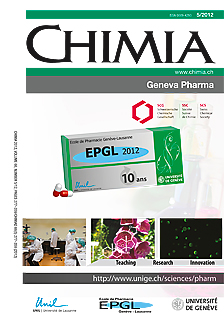Pharmaceutical Technology at the Service of Targeted Drug Delivery
DOI:
https://doi.org/10.2533/chimia.2012.308Keywords:
Drug delivery systems, Drug targeting, Molecular imaging, Theranostic agentsAbstract
Research in pharmaceutical technology has drifted from formulation of systems with improved drug absorption and bioavailability to systems targeting molecular sites of diseases. The research unit of Pharmaceutical Technology from the University of Geneva focuses on the development of systems for both diagnostic and therapeutic purposes. Three types of constructs for targeting are reviewed. With a fine-tuning of size and surface composition, polymeric nanoparticles are developed to improve detection of micrometastasis by fluorescence imaging. Furthermore, surface coating with specific antibodies increase the therapeutic efficiency of the encapsulated chemotherapeutic agent for tumor treatment in animal models. Constructs that are activated by remote sources of energy are investigated in the unit. For instance, microbubbles bearing specific antibody fragments at their surface are useful contrast agents for ultrasound molecular imaging. Microbubbles, if combined with a thrombolytic drug and ultrasound, improve clot lysis, which is promising for stroke treatments. Enzymatically activated prodrug scaffolds are also under development. With this approach, intrinsic enzymatic activity of a diseased tissue activates the formulations. This concept led to the development of theranostic agents that can be used for both diagnostic and therapeutic purposes.Downloads
Published
2012-05-30
Issue
Section
Scientific Articles
License
Copyright (c) 2012 Swiss Chemical Society

This work is licensed under a Creative Commons Attribution-NonCommercial 4.0 International License.
How to Cite
[1]
E. Allémann, F. Delie, N. Lange, Chimia 2012, 66, 308, DOI: 10.2533/chimia.2012.308.







